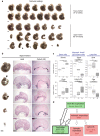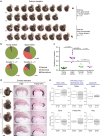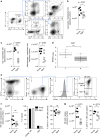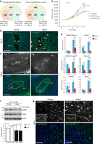Decidualisation and placentation defects are a major cause of age-related reproductive decline
- PMID: 28874785
- PMCID: PMC5585348
- DOI: 10.1038/s41467-017-00308-x
Decidualisation and placentation defects are a major cause of age-related reproductive decline
Abstract
Mammalian reproductive performance declines rapidly with advanced maternal age. This effect is largely attributed to the exponential increase in chromosome segregation errors in the oocyte with age. Yet many pregnancy complications and birth defects that become more frequent in older mothers, in both humans and mice, occur in the absence of karyotypic abnormalities. Here, we report that abnormal embryonic development in aged female mice is associated with severe placentation defects, which result from major deficits in the decidualisation response of the uterine stroma. This problem is rooted in a blunted hormonal responsiveness of the ageing uterus. Importantly, a young uterine environment can restore normal placental as well as embryonic development. Our data highlight the pivotal, albeit under-appreciated, impact of maternal age on uterine adaptability to pregnancy as major contributor to the decline in reproductive success in older females.Advanced maternal age has been associated with lower reproductive success and higher risk of pregnancy complications. Here the authors show that maternal ageing-related embryonic abnormalities in mouse are caused by decidualisation and placentation defects that can be rescued by transferring the embryo from an old to a young uterus.
Conflict of interest statement
The authors declare no competing financial interests.
Figures






Similar articles
-
Epigenetic changes occur at decidualisation genes as a function of reproductive ageing in mice.Development. 2020 Mar 17;147(6):dev185629. doi: 10.1242/dev.185629. Development. 2020. PMID: 32184271
-
REPRODUCTIVE AGEING: Altered histone modification landscapes underpin defects in uterine stromal cell decidualization in aging females.Reproduction. 2024 Aug 2;168(3):e240171. doi: 10.1530/REP-24-0171. Print 2024 Sep 1. Reproduction. 2024. PMID: 38995736 Free PMC article.
-
Altered uterine leptin signalling in obese mothers: from impaired decidualisation to pregnancy complications.Reproduction. 2025 Jan 9;169(2):e240319. doi: 10.1530/REP-24-0319. Print 2025 Feb 1. Reproduction. 2025. PMID: 39652640 Review.
-
Reduced maternal expression of adrenomedullin disrupts fertility, placentation, and fetal growth in mice.J Clin Invest. 2006 Oct;116(10):2653-62. doi: 10.1172/JCI28462. Epub 2006 Sep 14. J Clin Invest. 2006. PMID: 16981008 Free PMC article.
-
Current approaches and developments in transcript profiling of the human placenta.Hum Reprod Update. 2020 Nov 1;26(6):799-840. doi: 10.1093/humupd/dmaa028. Hum Reprod Update. 2020. PMID: 33043357 Free PMC article. Review.
Cited by
-
A Zika Vaccine Generated Using the Chimeric Insect-Specific Binjari Virus Platform Protects against Fetal Brain Infection in Pregnant Mice.Vaccines (Basel). 2020 Sep 2;8(3):496. doi: 10.3390/vaccines8030496. Vaccines (Basel). 2020. PMID: 32887302 Free PMC article.
-
Maternal age-specific risks for adverse birth weights according to gestational weight gain: a prospective cohort in Chinese women older than 30.BMC Pregnancy Childbirth. 2024 Jan 5;24(1):36. doi: 10.1186/s12884-023-06231-y. BMC Pregnancy Childbirth. 2024. PMID: 38182970 Free PMC article.
-
Epigenetic control of embryo-uterine crosstalk at peri-implantation.Cell Mol Life Sci. 2019 Dec;76(24):4813-4828. doi: 10.1007/s00018-019-03245-8. Epub 2019 Jul 27. Cell Mol Life Sci. 2019. PMID: 31352535 Free PMC article. Review.
-
DNA methylation abnormalities induced by advanced maternal age in villi prime a high-risk state for spontaneous abortion.Clin Epigenetics. 2023 Mar 21;15(1):44. doi: 10.1186/s13148-023-01432-w. Clin Epigenetics. 2023. PMID: 36945044 Free PMC article.
-
Self-Centered Function of Adaptive Immunity in Regulation of Immune Responses and in Tolerance.J Immunol Res. 2021 Dec 2;2021:7507459. doi: 10.1155/2021/7507459. eCollection 2021. J Immunol Res. 2021. PMID: 34950737 Free PMC article. Review.
References
-
- Martin JA, Hamilton BE, Osterman MJ, Curtin SC, Matthews TJ. Births: final data for 2013. Natl. Vital Stat. Rep. 2015;64:1–65. - PubMed
Publication types
MeSH terms
Grants and funding
LinkOut - more resources
Full Text Sources
Other Literature Sources
Medical
Molecular Biology Databases

